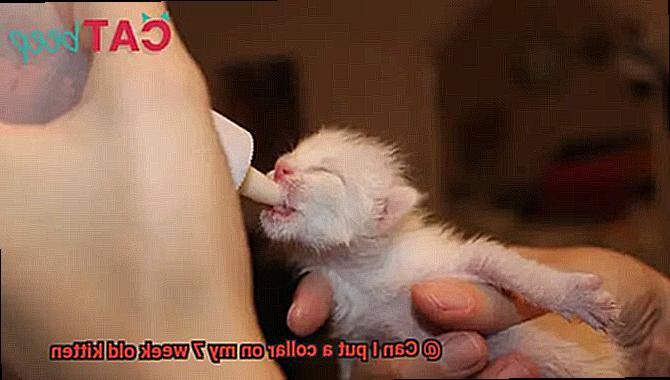Are you the proud owner of a 7-week-old kitten, and are you wondering if it’s safe to put a collar on your little furball? The answer isn’t black and white, but your kitten’s safety should be your top priority.
Putting a collar on your kitten can have its benefits. It can help identify your cat in case it gets lost or wanders off. Plus, collars can make for some adorable pictures of your furry friend.
However, there are a few things to consider before making this decision. A regular-sized collar may be too heavy and uncomfortable for their small necks, leading to breathing difficulties or even injury. Kittens are also more curious and playful than adult cats, so the likelihood of the collar getting caught is higher.
So what should you do? In this blog post, we’ll provide you with tips and insights on when and how to put a collar on your 7-week-old kitten, what type of collar is best suited for them, and how to ensure their safety while wearing one. Let’s dive in together.
Benefits of Collars for Kittens
Collars for kittens are not only adorable but also have many benefits. Here are some of the top reasons why collars are great for kittens:
Identification is key, and collars with tags containing your kitten’s name and your contact information can help in identifying them if they ever get lost. This is especially useful if your kitty is an outdoor adventurer.
Safety is always a top priority when it comes to our pets. Collars can be designed to easily breakaway if your kitten gets caught on something, preventing choking or strangulation hazards. This is particularly important for young kittens who are still exploring their surroundings.
Collars can also be used as a tool for training your kitten to walk on a leash. This not only helps with bonding but also helps your kitten get the exercise they need. Just make sure to choose a lightweight and comfortable material, such as nylon or leather, and never leave your kitten unattended while on a leash.
Fashionistas rejoice. Collars come in a variety of colors, patterns, and materials, making it easy to find the perfect collar that shows off your kitten’s personality and style.
It’s important to note that not all collars are created equal. Collars should fit snugly but not too tightly around your kitten’s neck, and it’s recommended to choose a lightweight and comfortable material such as nylon or leather. Additionally, it’s important to regularly check the collar for any signs of wear or tear and replace it if necessary.
Safety Considerations When Putting a Collar on Your 7 Week Old Kitten
Collars are not only stylish but also practical tools for identification, safety, and training. However, before you go ahead and put on that cute collar, it’s essential to consider your kitten’s safety first.
First things first, let’s talk about size. Kittens are small and delicate creatures, and their necks are still developing. Therefore, it’s crucial to get the right size collar for your kitten. A collar that is too loose could slip off and get caught on something, while one that is too tight could injure your kitten. To ensure a proper fit, you should be able to fit two fingers between the collar and your kitten’s neck.
The type of collar material is another important consideration. While leather collars are durable, they may be too heavy for a small kitten. Elastic collars can stretch over time and become too loose, posing a risk to your kitten’s safety. Nylon collars are lightweight and adjustable, making them an excellent option for kittens.
Adding an ID tag to the collar is also an important consideration. While it’s crucial for your kitten to have identification in case they get lost, tags can also pose a risk if they get caught on something. If you decide to add a tag, make sure it’s securely attached to the collar and check it regularly to ensure it hasn’t become loose.
And lastly, monitor your kitten closely after putting on the collar. Watch for any signs of discomfort or irritation such as scratching or excessive grooming. If your kitten seems uncomfortable with the collar, remove it immediately.
What Type of Collar Should I Choose?
Safety and comfort should be your top priority when it comes to selecting a collar for your furry friend.
The market is flooded with different types of collars, but not all of them are suitable for kittens. So, let’s dive into the most popular options and explore their pros and cons.
Breakaway collars are the safest option for your kitten. They come with a safety clasp that releases when pressure is applied to it. This feature prevents choking accidents if your kitten gets stuck or tries to pull away from the collar. Breakaway collars prioritize your kitten’s safety and prevent accidents that can lead to injury or even death.
If you’re looking for a more durable option, buckle collars made from nylon or leather could be a good choice. They come with a buckle that snaps into place around your kitten’s neck and last for a long time. However, it’s essential to keep a close eye on your kitten when they’re wearing a buckle collar as they can still pose a risk of choking if they get tangled on something.
For those who want to add some style to their kitten’s collar, rhinestone or charm collars may seem like an attractive option. However, it’s crucial to note that these collars require extra care and attention as rhinestones and charms can come loose and pose a choking hazard if ingested by your kitten.
How to Properly Fit the Collar
Fitting a collar on your 7 week old kitten is an important step in keeping them safe and secure. Here are some tips to make sure you do it right:
Choose the Right Size

To ensure a comfortable fit, measure your kitten’s neck circumference with a soft measuring tape. Add an inch to this measurement for growth and comfort. Look for collars that are lightweight and adjustable.
Opt for a Breakaway Collar
Breakaway collars are designed to release if they get caught on something, preventing any potential choking hazards. This is especially important for young kittens who are still learning to explore their surroundings.
Position the Collar Correctly
When putting on the collar, make sure it is positioned correctly. The buckle should be on the underside of the neck and the tags should be facing outward. This will prevent any discomfort or irritation from the buckle rubbing against your kitten’s skin.
Regularly Check the Fit
As your kitten grows, you may need to adjust the collar or switch to a larger size to ensure that it fits properly. Regularly check the fit of the collar by placing two fingers between the collar and your kitten’s neck. If you can’t fit two fingers, it’s too tight.
Keep Identification Information Up-to-Date
Make sure any tags or identification information on the collar are up-to-date and legible. This can help reunite your kitten with you if they become lost.
Checking the Collar for Wear and Tear
A collar is not only a fashion statement but also a vital tool in keeping your 7-week-old kitten secure. However, with time and use, the collar can incur wear and tear, which could put your kitten at risk. To prevent this from happening, regularly examine the collar for any signs of damage.
Here are some critical aspects to consider when checking your kitten’s collar:
- Material quality: Cheap collars can fray or thin easily, making them prone to breakage. If your kitten were to escape and get lost, the collar would be ineffective in helping them return home. Therefore, it’s essential to invest in a durable collar that can withstand wear and tear.
- Proper fit: A collar that’s too tight can cause discomfort and even injury to your kitten’s neck, while one that’s too loose can easily slip off and get lost. Ensure that you can fit two fingers between the collar and your kitten’s neck to achieve a perfect fit.
- Sharp edges or protrusions: Your kitten’s safety should always come first. Check for rough edges or metal tags that could scratch or cut your kitten’s skin, leading to infection or discomfort.
Checking the collar for wear and tear isn’t only about keeping up appearances; it’s about safeguarding your furry friend’s wellbeing. If you notice any signs of damage, such as fraying, looseness, or sharp edges, replace the collar immediately with a new one that fits correctly and is made from high-quality materials.

Alternatives to Wearing a Collar
Luckily, there are several alternatives to wearing a collar that can still keep your kitten safe and happy.
One excellent alternative is microchipping. This procedure involves implanting a small chip under your kitten’s skin that contains identifying information, such as your contact details. While it may cost more than a collar, it provides a permanent form of identification that cannot be lost or removed. It’s a one-time procedure that can last for years and give you peace of mind knowing that your pet can be identified even if they lose their collar.
Another option is using breakaway collars. These collars are designed to come apart if they get caught on something, which can prevent serious injuries or accidents. For outdoor cats who may wander into dangerous areas, this type of collar is ideal.
If your kitten is still adjusting to wearing a collar, harnesses and leashes are also great alternatives. These allow you to have more control over your kitten during outdoor playtime or walks while avoiding the discomfort or irritation that some kittens may feel with wearing a traditional collar.
It’s crucial to consider your kitten’s individual needs and behaviors when deciding on an alternative to wearing a collar. Consulting with your veterinarian or animal behaviorist can provide valuable insight and advice tailored to your pet. Additionally, some other alternatives include ID tags attached to the cat carrier, tattoos, and GPS collars.
wrmroMoJGME” >
Conclusion
In conclusion, while collars can have their benefits, it’s crucial to prioritize your 7-week-old kitten’s safety above all else. Although collars can help identify your kitten if they get lost and make for some adorable pictures, there are several things to consider before making this decision.
Firstly, regular-sized collars may be too heavy and uncomfortable for their small necks, which could lead to breathing difficulties or even injury. Secondly, kittens are more curious and playful than adult cats, so the likelihood of the collar getting caught is higher.
When considering putting a collar on your kitten, it’s essential to choose the right size and material. Breakaway collars are the safest option as they come with a safety clasp that releases when pressure is applied to it. Buckle collars made from nylon or leather could also be a good choice for those looking for durability.
However, always keep a close eye on your kitten when they’re wearing any type of collar as they can still pose a risk of choking if they get tangled on something. If you decide not to put a collar on your kitten, there are several alternatives such as microchipping or using breakaway collars that can still keep them safe and happy.
Ultimately, consulting with your veterinarian or animal behaviorist can provide valuable insight and advice tailored to your pet’s individual needs and behaviors.







